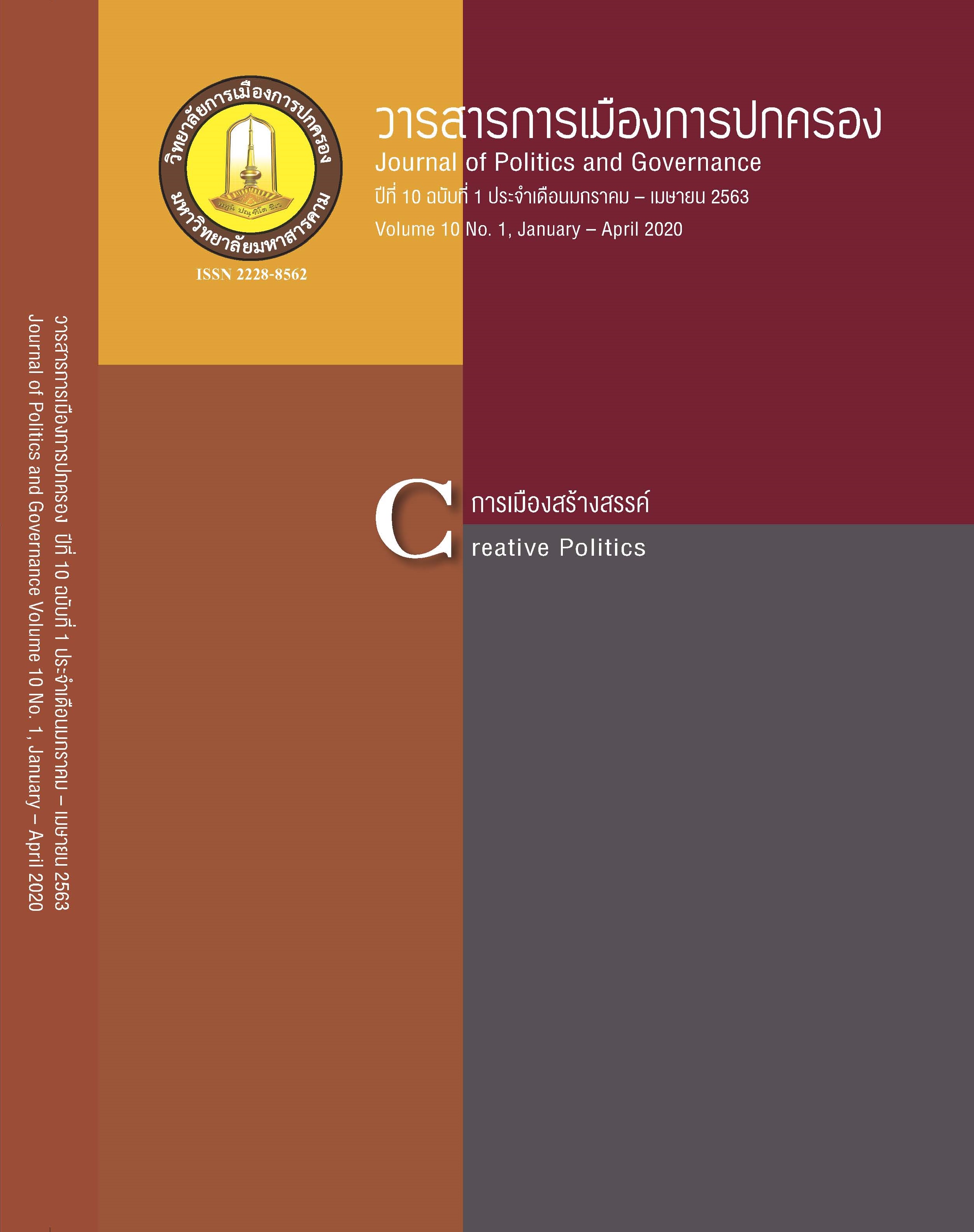Study on Personnel Potential for Preparation to Enter into a Happy Organization in the Lower Northern Cluster (Phitsanulok, Phichit, Phetchabun and Sukhothai)
Main Article Content
Abstract
The objective of this research is to identify the ideal content that should be considered in the creation of a happy workplace course, specifically for undergraduate students in the Northern region who are majoring in business administration. The purpose of this course is to ensure that students will be prepared to work in a happy organization in the Lower Northern Cluster (Phitsanulok, Phichit, Phetchabun and Sukhothai). In this study, the researcher conducted qualitative research including in-depth interviews and focus groups, utilizing the Delphi technique. The target group was comprised of 23 senior executive personnel in higher and middle-lower levels, including the operational level. Based on the findings, experts commented that course content should include knowledge in various fields to ensure the students’ readiness to work in a happy organization and that this subject should be included in the Human Resource Management Curriculum of Business Administration Department. The suggested content of the happy workplace course, then, can be divided into the following lessons: 1) Being open-minded 2) Understanding the nature of organization, 3) Patience, positive thinking, forgiveness, 4) Happy workplace culture, 5) Happy workplace leader, 6) Happy workplace policy, 7) Dealing with difficult people, 8) Happy workplace communication, 9) Considering that the problem is not a problem, 10) Creating common goals, 11) Self-Esteem, and 12) Public-focused mindset. The 12 suggested lessons for this course were created based on the priorities and necessities of knowledge for employees and organizations as recommended by specialists. This content is expected to increase engagement and improve loyalty in the organization. The results of this research can be applied to curriculum development for undergraduate courses, particularly the major in Human Resource Management within the Business Administration Department, so that students will be prepared to work in a happy workplace, leading to organization sustainability.
Article Details
References
จิรา เติมจิตรอารีย์ (2550). How to live happily. เข้าถึงเมื่อ 9 กันยายน 2556. สืบค้นจาก https://med.mahidol.ac.th/ramamental/generalknowledge/05222014-0813
ชัยวัฒน์ สุทธิรัตน์. (2552). สอนเด็กให้มีจิตสาธารณะ.จิตสำนึก-แง่สังคม. กรุงเทพฯ : วี พริ้นท์
ชาญวิทย์ วสันต์ธนารัตน์ และ ธีร์ธรรม วุฑฒิชัยแก้ว. (2559). มาสร้างองค์กรแห่งความสุขกันเถอะ ฉบับปรับปรุง พ.ศ.2559. กรุงเทพฯ : แอทโฟร์พรินท์.
ณัฏฐพันธ์ เขจรนันท์. (2541). การจัดการทรัพยากรมนุษย์. กรุงเทพฯ : ซีเอ็ดยูเคชั่น.
ดุษฎี โยเหลา และคณะ. (2550). การประเมินผลการดําเนินงานตามแผนกลยุทธของมหาวิทยาลัย ศรีนครินทรวโรฒิ รายงานการวิจัย. กรุงเทพฯ: กองแผนงานมหาวิทยาลัยศรีนครินทรวโรฒ.
ถิตรัตน์ พิมพาภรณ์ และประสพชัย พสุนนท์ (2559) .องค์ประกอบความสุขในการทำงานของพนักงานระดับปฏิบัติการในธุรกิจโรงแรมเมืองพัทยา. วารสารวิชาการ Veridian Ejournal, Sipakorn University, 9(1),121-139.
ทองพันชั่ง พงษ์วารินทร์. (2560). คิดบวก (Positive Thinking) เพื่อทำให้การแก้ไขปัญหาง่ายขึ้น. สืบค้นเมื่อ 10 กรกฎาคม 2556. สืบค้นจาก https://www.hrcenter.co.th/ file/columns/hr_f_20170510 _142300.pdf
ธีระ ชัยยุทธยรรยง. (2542). การเสริมสร้างความรู้สึกเห็นคุณค่าในตนเอง. วารสารวิชาการ, 2(2), 69
บุญจง ขาวสิทธิวงษ์. (2550). Happy Workplace. Journal of Social Development, 9(2). สืบค้นจาก https://tci-thaijo.org/index.php/jsd/article/view/31228.
บุญญาภา แจ้งสี. (2544). การศึกษาเปรียบเทียบรูปแบบการอบรมเลี้ยงดูที่มีผลต่อความผูกพันใกล้ชิดการเห็นคุณค่าในตนเอง และการยอมรับตนเองของนักศึกษาที่พฤติกรรมเสี่ยง และไม่เสี่ยงของสถาบันเทคโนโลยีราชมงคล วิทยาเขตพระนครใต้. วิทยานิพนธ์ปริญญามหาบัณฑิต,มหาวิทยาลัยรามคำแหง.
บุญธรรม กิจปรีดาบริสุทธิ์. (2540). ระเบียบวิธีการวิจัยทางสังคมศาสตร์. (พิมพ์ครั้งที่ 7) กรุงเทพฯ: เจริญผล.
ปิยะดา ศรประทุม. (2548). บรรยากาศองค์การและพฤติกรรมการเป็นสมชิกที่ดีขององค์การของ พนักงานบริษัทผลิตสื่อโทรทัศน์. สารนิพนธ์ศิลปะศาสตรมหาบัณฑิต, สาขาจิตวิทยา อุตสาหกรรมและองค์การ, คณะครุศาสตร์อุตสาหกรรม, สถาบันเทคโนโลยีพระจอมเกล้าพระนครเหนือ
ผจญ เฉลิมสาร. (2540). Quality of work life. Productivity world, 2(7) 22-25. กรุงเทพฯ: โปรดักทิวิตี้เวิร์ด.
พยอม วงศ์สารศรี. (2538). องค์การและการจัดองค์การ. กรุงเทพ ฯ : สถาบันราชภัฏสวนดุสิต.
พันธวัช ภูผาพันธกานต์(2559.) คู่มือการสร้างสุขภาวะ: ซีโน พับลิชชิ่ง แอนด์ แพคเกจจิ้ง.
พิเชฐ ทรวงโพธิ์,วนัทนีย์ ภูมิภัทราคม และธีร์ธนิกษ์ ศิริโวหาร (2553).ความสัมพันธ์ระหว่างรูปแบบวัฒนธรรมองค์กร กับแรงจูงใจในการทำงานของบุคลากรกรมทรัพยากรน้ำบาดาล. วารสารบัณฑิตศึกษา มหาวิทยาลัยราชภัฏวไลยอลงกรณ์, 4(2),1-14
รัศมี ธันยธร. (2547). Six Thinking Hats and Lateral Thinking สืบค้นจาก http://www.creativitycenter.co.th/public-main.php
ลลิลธร มะระกานนท์. (2550). การศึกษาการรับรู้บรรยากาศองค์กร ซึ่งส่งผลต่อความผูกพัน ของพนักงานสายการผลิตในบริษัท เอกชน. สถาบันเทคโนโลยีพระจอมเกล้าพระนครเหนือ, ม.ป.ท
ลักขณา ศิรถรกุล,วาสนา อูปป้อ และจรูญลักษณ์ ป้องเจริญ .(2556) Happy workplace and quality of work life in nurse instructors at Praboromarajchanok Institute. วารสารวิทยาลัยพยาบาลพระปกเกล้า จันทบุรี, 24(1), 10-21.
วรวุฒิ กิจสิริวิศาล. (2553). วัฒนธรรมองค์กรออกแบบรถไฟฟ้าของ รฟม.:โครงการรถไฟฟ้าสายสีน้ำเงินส่วนต่อขยาย. วิทยานิพนธ์วิทยาศาสตร์มหาบัณฑิต มหาวิทยาลัยศิลปากร.
วิจารณ์ พานิช. (2550). คิดเชิงบวก. สืบค้นจาก http://www.gotoknow.org/blog/thaikm/16179.
ศูนย์ประสานงานเครือข่ายประชาคมอาเซียนด้านการสาธารณสุข. (2560). กรมอนามัยเน้น Health Literacy หวังคนไทยรอบรู้ด้านสุขภาพมุ่งสู่ประเทศไทย 4.0. เข้าถึงเมื่อ 17 สิงหาคม 2560 สืบค้นจาก http://10875.ahnckorat.com/index.php/13-pr/51-jkr
ศิรินันท์ กิตติสุขสถิต และคณะ.(2556). คุณภาพชีวิต การทำงาน และความสุข. สืบค้นจาก http://www.ipsr.mahidol.ac.th/ipsrbetaa/Fileupload/PDF/Report-File-405.pdf.
สถาบันเพิ่มผลผลิตแห่งชาติ. (2552). งานได้ผล คนเป็นสุข (Healthy organization productivity). กรุงเทพฯ: โรงพิมพ์ตะวันออก.
สุธาสินี โพธิจันทร์. (2561). คนต้องพร้อมสำหรับองค์กรยุค 4.0 สืบค้นจาก https://www.ftpi.or.th /2018/21477
Gray, R. (2007). A Climate of success. Oxford: Elsevier.
Lyubomirsky, S., King, L. and Diener, E. (2005). The benefits of frequent positive affect: Does happiness lead to success? Psychological Bulletin, 131(6), 803–855.
Macmillan, T. T. (2012). The Delphi technique. Washington, D.C: ERIC Clearinghouse.


